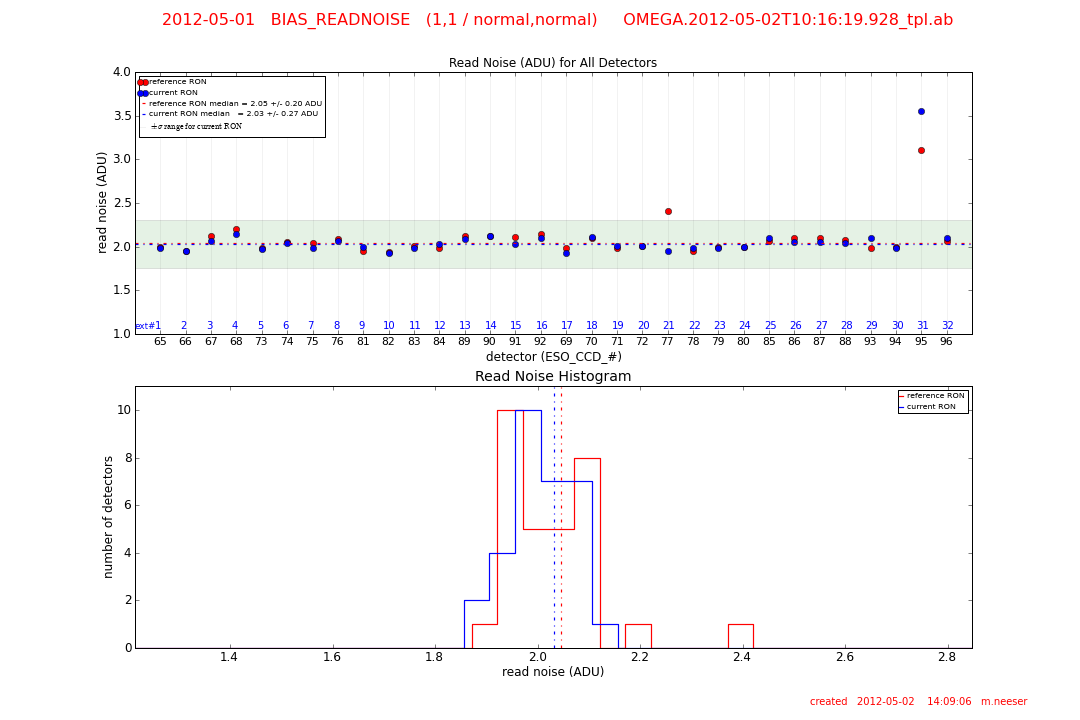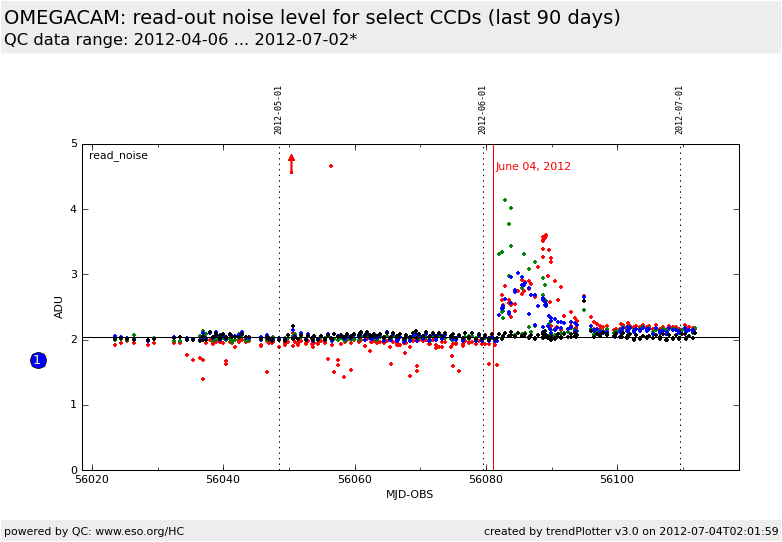|
|
 |
| |
| QC PLOTS |
| BIAS READ NOISE: |
CURRENT |
HISTORY |
| read-out noise |
 |
 |
| read-out noise for selected CCDs |
 |
 |
| |
| QC1 database (advanced users):
browse
|
plot |
Click on CURRENT to see the current trending (Health Check).
Click on HISTORY to see the historical evolution of the trending. |
BIAS read-out noise frames are taken on a daily basis during normal VST/OmegaCAM operations. They are usually obtained during day-time calibration and consist of two, zero second, closed shutter, raw bias exposures. The rms scatter of the difference frame of these two bias exposures (divided by sqrt(2)) is the read noise in ADU.
The pipeline creates one output frame from its bias-readnoise recipe (omega_readnoise):
a fits table containing the read-noise values for each extension (OC_PRNA_<date>_1_1_normal_normal.fits).
top
READ-OUT NOISE parameters trended
|
QC1 Health Check Plots
The QC1 health check plots for the OmegaCAM BIAS frames are divided into 5 separate linked pages, two of which monitor the BIAS,READNOISE QC1 parameters including:
- the bias read-out noise averaged over all 32 extensions (ADU)
- the bias read-out noise for each extension (ADU)
- the read-out noise for a selection of four detectors (ESO_CCD #81, #82, #83, and #75)
QC1 parameters (trended for each individual detector)
| Parameter |
Table: Name (QC1 database) |
Description of Procedure |
| read-out noise |
omegacam_readnoise: qc.ron |
The read-out noise is determined from a pair of zero-second bias exposures. The rms scatter of the difference frame of these two bias exposures (divided by sqrt(2)) is the read noise in ADU. |
median difference between the two input bias frames
|
omegacam_readnoise: qc.ron.med.diff |
The median value of the difference between the two input bias frames (ADU). |
| mean difference between the two input bias frames |
omegacam_readnoise: qc.ron.mean.diff |
The mean value of the difference between the two input bias frames (ADU). |
| raw bias1 frame statistics |
omegacam_readnoise: qc.raw.bias1.min/max/mean/median/stdev |
The statistics of the first bias frame in the read-out noise template (ADU). The intent is to monitor these basic parameters for the less stable detectors, in particular, ESO_CCD_#82. |
| raw bias2 frame statistics |
omegacam_readnoise: qc.raw.bias2.min/max/mean/median/stdev |
The statistics of the second bias frame in the read-out noise template (ADU). The intent is to monitor these basic parameters for the less stable detectors, in particular, ESO_CCD_#82. |
| average temperature of the two detector plate probes |
omegacam_readnoise: qc.temp.mosaic.plate |
The average value of the header temperature keyword DET.TLM5 and DET.TLM8, both of which probe the temperature of the mosaic plate (Kelvin). |
QC Reports for BIAS,REANOISE Frames

QC Report 1:
Read-out noise QC report for all detectors:
top: displays the level of the read-out noise (in ADU) for each of the 32 OmegaCAM detectors. The blue points are for the current read-out noise frame, while the red points are the reference values. The median RON level is indicated as a blue line (current value) and as a red line (reference value) and are listed in the frame legend. The shaded green area indicates the +/- 1 sigma value of the RON for all current detectors.
bottom: a read-out noise histogram indicating the RON (in ADU) vs. the number of detectors having this read noise. The blue histogram indicates the current read noise frame, while the red histogram is the reference frame.
Trending and Issues
The read-out noise for all OmegaCAM detectors should be below about 2.5 ADU (detector #95 being the exception), and should not vary by more than +/- 0.3 ADU from its reference values.
Any sudden changes in the read-out noise level for any detector, can be detected in the health check plots and/or the QC parameters and their thresholds.
History
2012-06-04: Following the replacement of a video board in order to address striping present in detector ESO_CCD_#82, the three detectors surrounding this CCD (namely, #81 and #83) displayed strongly varying read-noise levels. After about two weeks this behaviour settled down by itself. This is evident in the health check plot monitoring the read-out noise of these three detectors (red, blue and green points) and the unaffected detector (#75, black points) shown below.

2016-10: occassional increase of the RON in CCD_69 and CCD_77
|
![[ ESO ]](/images/eso-logo.gif)
![[ ESO ]](/images/eso-logo.gif)
